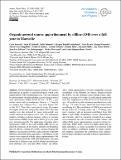Por favor, use este identificador para citar o enlazar a este item:
http://hdl.handle.net/10261/174551COMPARTIR / EXPORTAR:
 SHARE SHARE
 CORE
BASE CORE
BASE
|
|
| Visualizar otros formatos: MARC | Dublin Core | RDF | ORE | MODS | METS | DIDL | DATACITE | |

| Título: | Organic aerosol source apportionment by offline-AMS over a full year in Marseille |
Autor: | Bozzetti, Carlo; Minguillón, María Cruz CSIC ORCID ; Prévôt, André S.H. | Palabras clave: | Aerosoles Air quality Water-soluble ions Mass Spectrometry |
Fecha de publicación: | 7-jul-2017 | Editor: | Copernicus Publications | Citación: | Atmospheric Chemistry and Physics 17 (13): 8247-8268 (2017) | Resumen: | We investigated the seasonal trends of OA sources affecting the air quality of Marseille (France), which is the largest harbor of the Mediterranean Sea. This was achieved by measurements of nebulized filter extracts using an aerosol mass spectrometer (offline-AMS). In total 216 PM2.5 (particulate matter with an aerodynamic diameter < 2.5 μm) filter samples were collected over 1 year from August 2011 to July 2012. These filters were used to create 54 composite samples which were analyzed by offline-AMS. The same samples were also analyzed for major water-soluble ions, metals, elemental and organic carbon (EC/OC), and organic markers, including n-alkanes, hopanes, polycyclic aromatic hydrocarbons (PAHs), lignin and cellulose pyrolysis products, and nitrocatechols. The application of positive matrix factorization (PMF) to the water-soluble AMS spectra enabled the extraction of five factors, related to hydrocarbon-like OA (HOA), cooking OA (COA), biomass burning OA (BBOA), oxygenated OA (OOA), and an industry-related OA (INDOA). Seasonal trends and relative contributions of OA sources were compared with the source apportionment of OA spectra collected from the AMS field deployment at the same station but in different years and for shorter monitoring periods (February 2011 and July 2008). Online- and offline-AMS source apportionment revealed comparable seasonal contribution of the different OA sources. Results revealed that BBOA was the dominant source during winter, representing on average 48 % of the OA, while during summer the main OA component was OOA (63 % of OA mass on average). HOA related to traffic emissions contributed on a yearly average 17 % to the OA mass, while COA was a minor source contributing 4 %. The contribution of INDOA was enhanced during winter (17 % during winter and 11 % during summer), consistent with an increased contribution from light alkanes, light PAHs (fluoranthene, pyrene, phenanthrene), and selenium, which is commonly considered as a unique coal combustion and coke production marker. Online- and offline-AMS source apportionments revealed evolving levoglucosan : BBOA ratios, which were higher during late autumn and March. A similar seasonality was observed in the ratios of cellulose combustion markers to lignin combustion markers, highlighting the contribution from cellulose-rich biomass combustion, possibly related to agricultural activities. © 2017 Author(s). | Versión del editor: | https://doi.org/10.5194/acp-17-8247-2017 | URI: | http://hdl.handle.net/10261/174551 | DOI: | 10.5194/acp-17-8247-2017 |
| Aparece en las colecciones: | (IDAEA) Artículos |
Ficheros en este ítem:
| Fichero | Descripción | Tamaño | Formato | |
|---|---|---|---|---|
| Organic aerosol source apportionment by offline-AMS over a full.pdf | 7,85 MB | Adobe PDF |  Visualizar/Abrir |
CORE Recommender
SCOPUSTM
Citations
68
checked on 22-abr-2024
WEB OF SCIENCETM
Citations
59
checked on 25-feb-2024
Page view(s)
189
checked on 22-abr-2024
Download(s)
150
checked on 22-abr-2024
Google ScholarTM
Check
Altmetric
Altmetric
NOTA: Los ítems de Digital.CSIC están protegidos por copyright, con todos los derechos reservados, a menos que se indique lo contrario.
